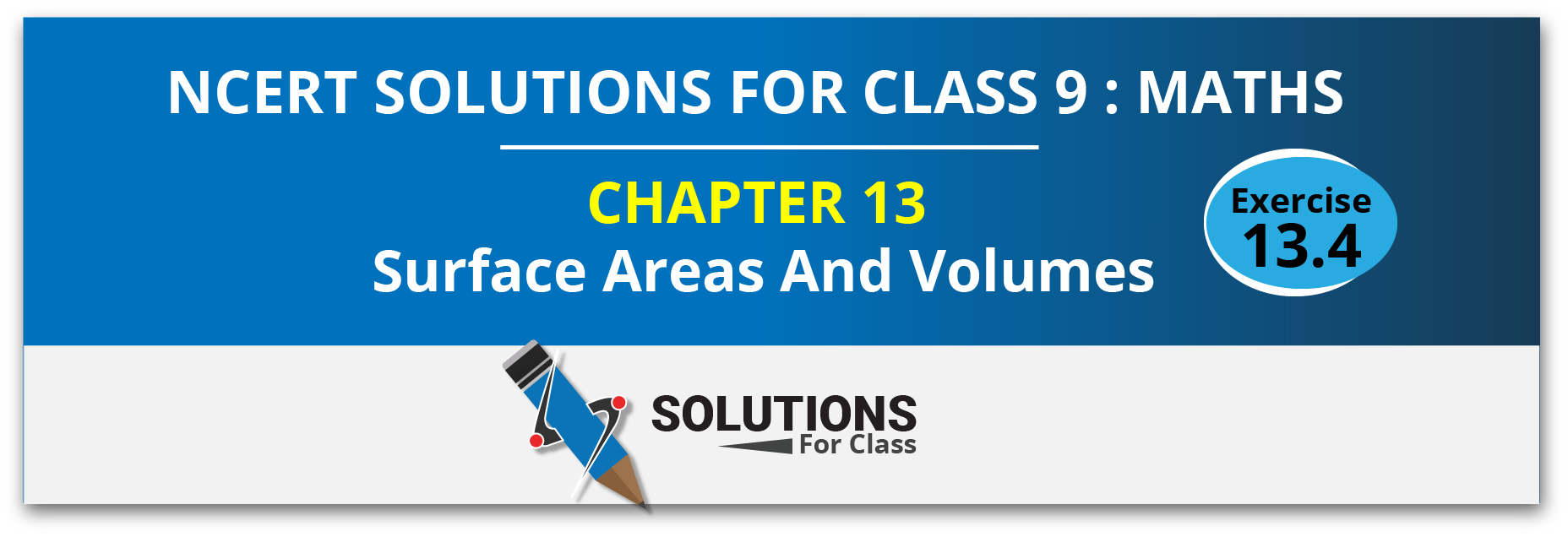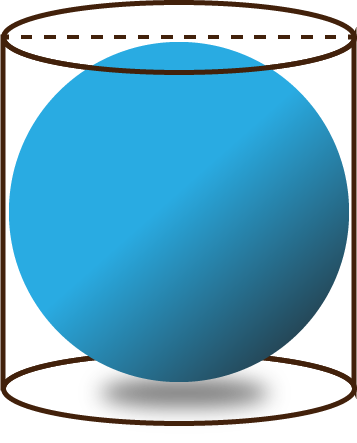NCERT Solution For Class 9, Maths, Chapter 13, Surface Areas And Volumes, Exercise 13.4 is all about study of curved surface area of sphere and hemisphere which are well explained. Exercise 13.4 class 9, maths solutions contains total nine questions which are given below.
Table of Contents
Toggle
Class 9, Maths, Chapter 13, Exercise 13.4 Solutions (Page no. 225)
Q.1. Find the surface area of a sphere of radius:
(i) 10.5 cm
(ii) 5.6 cm
(iii) 14 cm
Ans: (i) We have: r = radius of the sphere = 10.5 cm
Surface area = 4πr2
$=4\times \frac{22}{7}\times 10.5\times 10.5\,\,c{{m}^{2}}$
=1386 cm2
(ii) We have: r = radius of the sphere = 5.6 cm
Surface area = 4πr2
$=4\times \frac{22}{7}\times 5.6\times 5.6\,c{{m}^{2}}$
= 394.24 cm2
(iii) We have: r = radius of the sphere = 14 cm
Surface area = 4πr2
$=4\times \frac{22}{7}\times 14\times 14\,c{{m}^{2}}$
=2464 cm2
Q.2. Find the surface area of a sphere of diameter:
(i) 14 cm
(ii) 21 cm
(iii) 3.5 m
Ans: (i) Here r =$\frac{14}{2}$cm = 7 cm
Surface area = 4πr2
$=4\times \frac{22}{7}\times 7\times 7\,\,c{{m}^{2}}$
= 616 cm2
(ii) Here r = $\frac{21}{2}$cm = 10.5 cm
Surface area = 4πr2
$=4\times \frac{22}{7}\times 10.5\times 10.5\,\,c{{m}^{2}}$
= 1386 cm2
(iii) Here r = $\frac{3.5}{2}$cm = 1.75 cm
Surface area = 4πr2
$=4\times \frac{22}{7}\times 1.75\times 1.75\,\,c{{m}^{2}}$
= 38.5 cm2
Q.3. Find the total surface area of a hemisphere of radius 10 cm. (Use π = 3.14)
Ans: Here r = 10 cm,
Total surface area of hemisphere
= 3πr2 = (3 × 3.14 × 10 ×10) cm2
= 942 cm2
Q.4. The radius of a spherical balloon increases from 7 cm to 14 cm as air is being pumped into it. Find the ratio of surface areas of the balloon in the two cases.
Ans: Let r1 and r2 be the radius of balloons in the two cases.
Here r1 = 7 cm and r2 = 14 cm
Ratio of their surface areas = $\frac{4\pi r_{1}^{2}}{4\pi r_{2}^{2}}=\frac{r_{1}^{2}}{r_{2}^{2}}=\frac{7\times 7}{14\times 14}=\frac{1}{4}$
Thus, the required ratio of their surface areas = 1 : 4
Q.5. A hemispherical bowl made of brass has inner diameter 10.5 cm. Find the cost of tin-plating it on the inside at the rate of ₹16 per 100 cm2.
Ans: Here $r=\frac{10.5}{2}$cm = 5.25 cm
Curved surface area of the hemisphere
$=2\pi {{r}^{2}}=\left( 2\times \frac{22}{7}\times 5.25\times 5.25 \right)c{{m}^{2}}$
= 173.25 cm2
Rate of tin-plating is Rs 16 per 100 cm2
Cost of tin-plating the hemisphere
= ₹ $\left( 173.25\times \frac{16}{100} \right)$ = ₹ 27.72
Q.6. Find the radius of a sphere whose surface area is 154 cm2.
Ans: Let r be the radius of the sphere.
Surface area = 154 cm2
⇒ 4πr2 = 154
⇒ $4\times \frac{22}{7}\times \,\,{{r}^{2}}=154$
⇒ $\,{{r}^{2}}=\frac{154\times 7}{4\times 22}=12.25$
⇒ $r=\sqrt{12.25}=3.5$ cm
Thus, the radius of the sphere is 3.5 cm.
Q.7. The diameter of the moon is approximately one fourth of the diameter of the earth. Find the ratio of their surface areas.
Ans: Let the diameter of earth be R and that of the moon R will be $\frac{R}{4}$
The radii of moon and earth are $\frac{R}{8}$ and $\frac{R}{2}$respectively.
Ratio of their surface area = $\frac{4\pi {{\left( \frac{R}{8} \right)}^{2}}}{4\pi {{\left( \frac{R}{2} \right)}^{2}}}=\frac{\frac{1}{64}}{\frac{1}{4}}$
⟹ $\frac{1}{64}\times \frac{4}{1}=\frac{1}{16}\,\,i.e.,\,1\,\,\,:\,\,16$
Q.8. A hemispherical bowl is made of steel, 0.25 cm thick. The inner radius of the bowl is 5 cm. Find the outer curved surface area of the bowl.
Ans: Inner radius, r = 5 cm
Thickness of steel = 0.25 cm
Outer radius, R = (r + 0.25) cm = (5 + 0.25) cm = 5.25
Now, outer curved surface = 2πR2
$=2\times \frac{22}{7}\times 5.25\times 5.25\,\,c{{m}^{2}}$
= 173.25 cm2
Q.9. A right circular cylinder just encloses a sphere of radius r (see Fig. 13.22). Find
(i) surface area of the sphere,
(ii) curved surface area of the cylinder,
(iii) ratio of the areas obtained in (i) and (ii).

Ans: (i) The radius of the sphere r, so its surface area = 4πr2
(ii) Since the right circular cylinder just encloses a sphere of radius r. So, the radius of cylinder = r and its height = 2r
Curved surface of cylinder = 2πr (2r) [∵ r = r, h = r]
= 4πr2
(iii) Ratio of areas = 4πr2 ∶ 4πr2 = 1 ∶ 1
NCERT Solutions For Class 9, Maths, Chapter 13, Surface Areas And Volumes (All Exercises)
- Class 9, Maths, Surface Areas And Volumes, Exercise 13.1
- Class 9, Maths, Surface Areas And Volumes, Exercise 13.2
- Class 9, Maths, Surface Areas And Volumes, Exercise 13.3
- Class 9, Maths, Surface Areas And Volumes, Exercise 13.4
- Class 9, Maths, Surface Areas And Volumes, Exercise 13.5
- Class 9, Maths, Surface Areas And Volumes, Exercise 13.6
- Class 9, Maths, Surface Areas And Volumes, Exercise 13.7
- Class 9, Maths, Surface Areas And Volumes, Exercise 13.8
- Class 9, Maths, Surface Areas And Volumes, Exercise 13.9

